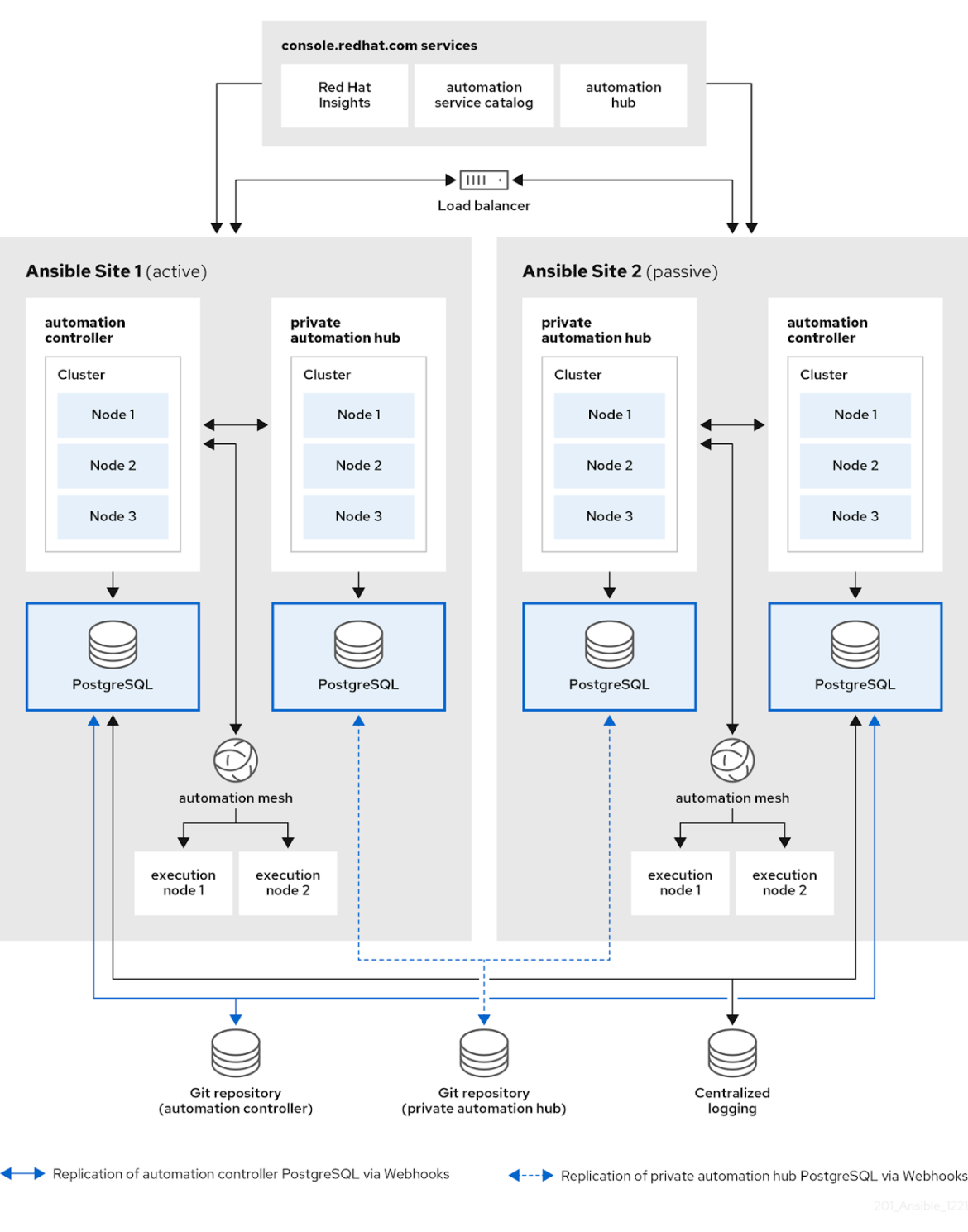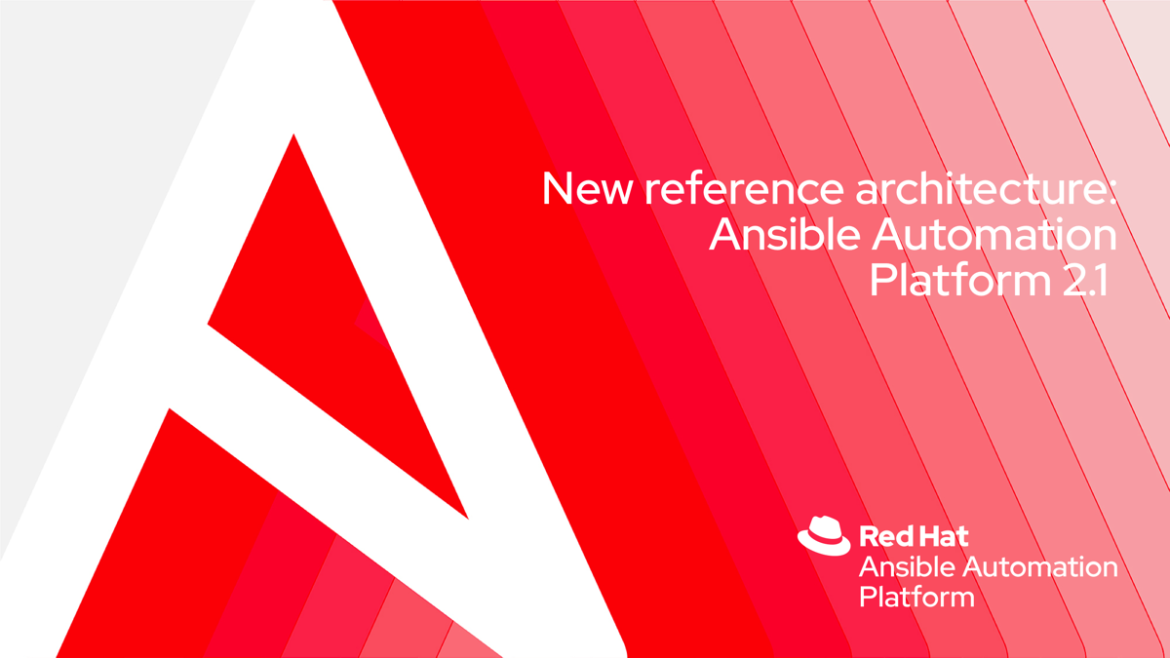With the release of Red Hat Ansible Automation Platform 2.1, we are proud to deliver the latest reference architecture on the best practices for deploying a highly available Ansible Automation Platform environment.
Why are you going to love it?This reference architecture focuses on providing a step-by-step deployment procedure to install and configure a highly available Ansible Automation Platform environment from start to finish.
But there’s more!
Aside from the key steps to install Ansible Automation Platform, it incorporates key building blocks to optimize your Ansible Automation Platform environments, including:
- Centralized logging across multiple Ansible Automation Platform environments.
- Securing installation inventory passwords using ansible-vault.
- Using a combination of GitOps practices (configuration as code capabilities) and Git webhooks to streamline the automation and delivery of configurations to multiple Ansible Automation Platform sites automatically, immediately and consistently.
What are the foundational pieces to this reference architecture?
The reference architecture consists of two environments of Ansible Automation Platform: Ansible Site 1 and Ansible Site 2 for high availability. Site 1 is an active environment while Site 2 is a passive environment. Each site consists of the following:
- A three node automation controller cluster with one PostgreSQL database.
- A three node automation hub cluster with one PostgreSQL database.
- Two execution nodes per automation controller cluster.
- Access to hosted services on console.redhat.com such as Red Hat Insights for Red Hat Ansible Automation Platform, automation services catalog and Ansible automation hub.
To achieve high availability (HA) for the PostgreSQL databases, GitOps in conjunction with Git webhooks are used when push or merge events are triggered on a Git repository, which in turn will configure the specified event on both Ansible Site 1 and Ansible Site 2.
Why was GitOps (Configuration as Code) used within this reference architecture?
By storing and managing Ansible Automation Platform configuration files as code, you can:
- Standardize the settings being applied to all our Ansible Automation Platform environments.
- Inherit the benefits of version control of our configurations.
- Easily scale additional Ansible Automation Platform deployments to use the same configuration settings.
- Easily track changes of the configuration settings, which helps fix issues easier.
Combining GitOps with Git webhooks, you can set up an Ansible Automation Platform workflow that immediately updates all of our Ansible Automation Platform sites simultaneously with the exact configurations across all the platforms.
In effect, it removes the overhead of having to maintain database backups or enable an expensive database replication solution, while still achieving the strengths of those solutions.
Finally, for logging consistency, a highly available centralized logging environment was installed on both Ansible Automation Platform environments.
Why was enabling centralized logging a key part of this reference architecture?
When we think about logging, the first thought that comes to mind is often its ability to troubleshoot a particular issue. As technology continues to evolve and there is an enormous amount of data that applications must capture, logs play a vital role in capturing this data and allowing for operational intelligence methods.
Ansible Automation Platform provides a logging feature that enables the capability to send detailed logs to any number of third party external log aggregation services. Services connected to this data feed serve as a useful means in gaining insight into automation controller usage or technical trends. The data can be used to analyze events in the infrastructure, monitor for anomalies, and correlate events from one service with events in another.
By taking advantage of the latest reference architecture, you inherit the most valuable benefits on how to best run the platform right from the start. And who doesn’t want that?
An image representing the reference architecture is provided below.

What can I do next?
Whether you are beginning your automation journey or are a seasoned veteran, there are a variety of resources to enhance your automation knowledge:
-
Latest Reference Architecture - Download the latest Deploying Red Hat Ansible Automation Platform 2.1 reference architecture for an in-depth step-by-step deployment HOWTO.
-
Self-paced exercises - Check out the interactive in-browser exercises to learn and dive into Ansible Automation Platform.
-
Trial subscription - Are you ready to go? Get your own trial subscription for unlimited access to all the components of Ansible Automation Platform.
-
Developer license - Did you know that you can get a free developer license to learn in your home lab? Register and get access to all the latest tools, technologies and community that Red Hat has to offer.
-
Subscribe to the Red Hat Ansible Automation Platform YouTube channel. Be sure to check out our new web series, Automated Live hosted by Colin McNaughton.
-
Follow Red Hat Ansible Automation Platform on Twitter - Do you have questions or an automation project you want to show off? Tweet at us!
Sobre el autor
Navegar por canal
Automatización
Las últimas novedades en la automatización de la TI para los equipos, la tecnología y los entornos
Inteligencia artificial
Descubra las actualizaciones en las plataformas que permiten a los clientes ejecutar cargas de trabajo de inteligecia artificial en cualquier lugar
Nube híbrida abierta
Vea como construimos un futuro flexible con la nube híbrida
Seguridad
Vea las últimas novedades sobre cómo reducimos los riesgos en entornos y tecnologías
Edge computing
Conozca las actualizaciones en las plataformas que simplifican las operaciones en el edge
Infraestructura
Vea las últimas novedades sobre la plataforma Linux empresarial líder en el mundo
Aplicaciones
Conozca nuestras soluciones para abordar los desafíos más complejos de las aplicaciones
Programas originales
Vea historias divertidas de creadores y líderes en tecnología empresarial
Productos
- Red Hat Enterprise Linux
- Red Hat OpenShift
- Red Hat Ansible Automation Platform
- Servicios de nube
- Ver todos los productos
Herramientas
- Training y Certificación
- Mi cuenta
- Soporte al cliente
- Recursos para desarrolladores
- Busque un partner
- Red Hat Ecosystem Catalog
- Calculador de valor Red Hat
- Documentación
Realice pruebas, compras y ventas
Comunicarse
- Comuníquese con la oficina de ventas
- Comuníquese con el servicio al cliente
- Comuníquese con Red Hat Training
- Redes sociales
Acerca de Red Hat
Somos el proveedor líder a nivel mundial de soluciones empresariales de código abierto, incluyendo Linux, cloud, contenedores y Kubernetes. Ofrecemos soluciones reforzadas, las cuales permiten que las empresas trabajen en distintas plataformas y entornos con facilidad, desde el centro de datos principal hasta el extremo de la red.
Seleccionar idioma
Red Hat legal and privacy links
- Acerca de Red Hat
- Oportunidades de empleo
- Eventos
- Sedes
- Póngase en contacto con Red Hat
- Blog de Red Hat
- Diversidad, igualdad e inclusión
- Cool Stuff Store
- Red Hat Summit


